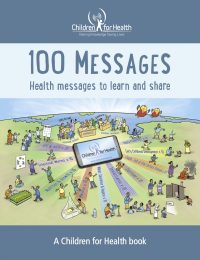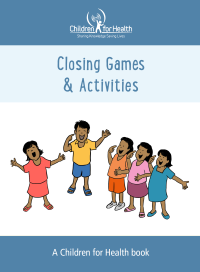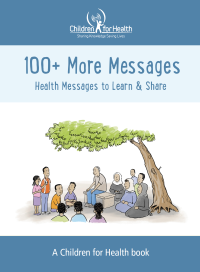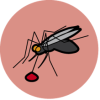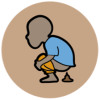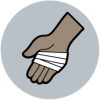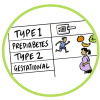Anti-Bullying
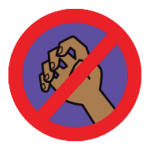
Read our top 10 messages on Anti-bullying to the right. They were developed over many months with input from experts, teachers and doctors. We developed a great poster for people to display in schools, medical facilities and anywhere children are.
You’ll see we never refer to anyone as ‘a bully.’ We talk about bullying behaviour and that can be changed. If someone bullies, they can spend time in a quiet room with a teacher (maybe memorising anti-bullying messages or slogans) or require them to attend a session after school to learn about how to stop bullying and make the school a kinder and safer place.
Scroll down to see ideas on what children can do to understand, find out more, take action and reflect on this topic.
Use the links below to browse our FREE resources to help children learn more, share their knowledge and become agents of change.
10 Messages on
Anti-bullying
Bullying is when someone keeps hurting, teasing, or threatening another person on purpose. It can happen at school, on the way home, at home, in the community, or even online.
Bulling can happen between individuals or in groups, and it affects everyone – making children feel scared, lonely or sad, families worry, and schools are unsafe for learning.
Types of bullying are: Physical (hitting, kicking, pushing); Verbal (name-calling, teasing or using mean words); Social/Emotional (leaving someone out, spreading rumours or embarrassing someone in front of others); Cyberbullying – through phones, messages or social media.
Every child deserves kindness and respect. Everyone is unique and differences are what makes us special.
Say NO to bullying when we see it. Don’t be a bystander. Stop bullying by helping and supporting others.
If you feel bullied, don’t fight back. Walk away and tell an older child, or a trusted adult like a teacher or parent.
Never share or send hurtful messages online. Show an older child or an adult if it happens. Don’t stay silent.
Everyone is responsible to ensure children feel safe. Together we can make our school a ‘bullying free zone’.
Children who bully others can change with support, leadership responsibilities, clear boundaries, and consequences to learn better ways.
Children who bully others often do it to gain control or seek attention. Stop a child bullying by standing together.
Children can learn, collect & share these messages!
While teaching these messages, encourage children to…
MAKE their own Anti-Bullying Messages using their own words in their own language!
LEARN these messages so they never forget them!
ADD these messages to their collection!
SHARE these messages with other children and their families!
If your class or group is struggling to stay connected and engaged, we have loads of ideas for ideas to help them! Have a look at Closing Games & Activities.
Use the questions/discussion topics below to help children to memorise the messages and really understand them.


What can children make, do or ask
to better understand this topic?
- STAND together and promise to make the school a “Bullying Free Zone”.
- START a Child Rights Club to support kindness, respect, and safety for everyone.
- PLAY the Resilience Dance: “Fall Over! Get Up! Forward 1, 2, 3! Back one! Super Better!” (See Our True Colours storybook for more).
- LISTEN to and DISCUSS stories about bullying – how it happens, how it makes people feel, and what can be done to stop it.
- WITH ADULTS, set up a “time-out” space where children who bully can reflect, talk, and join training led by older children or teachers.
- ASK each other important questions:
- Have you ever seen or experienced bullying?
- How does bullying make people feel?
- If you are bullied, what can you do and who can you talk to?
- What does it mean to be a bystander? How can you step up and help instead of staying silent?
- What can we do together to make a difference at school?
- WORK together on a school plan to prevent bullying. Think about:
- what each child can do for themselves,
- what one child can do for another,
- and what children can do together as a group.
- CREATE colourful posters with strong anti-bullying slogans for our classrooms and playgrounds.
- MAKE our own Anti-Bullying messages using our own words and in our own language.
- MEMORISE the messages so we never forget them.
- MEMORISE and use these 10 slogans, one for each finger:
- Be a Friend, Do Not Bully Others
- Speak Up, Stand Strong
- Words Can Hurt, Choose Kindness
- You Are Not Alone
- Online or Offline, Bullying is Never Okay
- Different is Cool
- Helping Someone is Never Wrong
- Strength is in Kindness
- Be the Reason Someone Smiles Today
- Together We Can Stop Bullying
- SHARE the anti-bullying messages and slogans with friends, families, and neighbours.
- INVITE a social worker, police, teacher, or community leader to answer questions about how bullying harms children, families, schools, and the community.
- MAKE UP and ACT OUT a play to show what happens when someone sees another child being bullied and how to help.
- OBSERVE playtime and NOTICE if different types of bullying happen. Record what you see and discuss it.
Download these free materials now to help children learn and share these essential health messages. See our free resource section for more!




